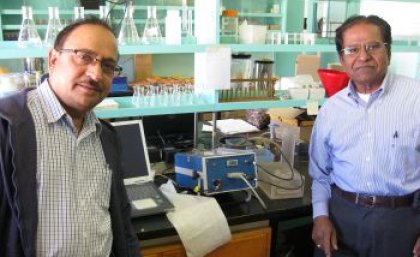
UQ and American scientists have developed a quick, new, low-cost way of monitoring the moisture content of peanuts in the shell.
Queensland Alliance for Agriculture and Food Innovation (QAAFI) crop scientist, Dr RCN Rachaputi, has been field testing a non-destructive radio frequency-based technology, originally developed by scientists at the United States Department of Agriculture (USDA).
Dr Rachaputi said there were many advantages to the new technology, which promised a range of applications to post-harvest grain quality improvements.
“Rapid assessment of pod moisture is critical to monitoring peanut quality, including efficacy of the post-harvest drying process – and current methods are costly and laborious,” Dr Rachaputi said.
The prototype probe is being assessed for the first time in the Australian peanut industry as part of the Grains Research and Development Corporation-funded Peanut Agronomy Project led by Dr Rachaputi.
Technical aspects of the research have been undertaken by Queensland Government Department of Agriculture, Fisheries and Forestry project team members under the leadership of Dr Rachaputi.
“While the radio frequency-based technology works perfectly well for assessing moisture content of peanut pods and kernels, initial trials are indicating scope for applying the technology to other grain industries, including assessing oil content and quality of biomaterials,” he said.
“The system can also be applied to non-destructively measuring oil content in single kernels, which is of great value for breeders.
“Initially we’ll be exploring opportunities for commercialising the system for rapid assessment of pod and kernel moistures in the drying bins, at the intake points, as well as within the peanut processing plants.”
The science underpinning the relationship between radio signals and moisture content has been developed since the late 1990s but the prototype hardware to measure the moisture content of single or bulk peanut pods (non-destructively) using radio frequency signals was first developed by Dr Chari Kandala at USDA’s National Peanut research lab in 2006.
Dr Rao Rachaputi is a Senior Research Fellow in the QAAFI Centre for Plant Science. He has more than 25 years’ experience in crop physiological research on high value summer grain legumes.
Media: Contact: Dr Rao Rachaputi (also known as RCN)
Email: rao.rachaputi@uq.edu.au
Phone: 07 4160 0737



